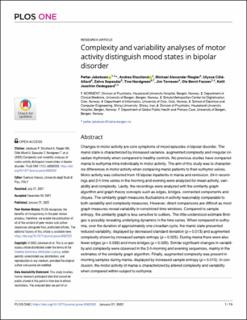Complexity and variability analyses of motor activity distinguish mood states in Bipolar Disorder
Jakobsen, Petter; Stautland, Andrea; Riegler, Michael; Côté-Allard, Ulysse Teller Masao; Sepasdar, Zahra; Nordgreen, Tine; Tørresen, Jim; Fasmer, Ole Bernt; Ødegaard, Ketil Joachim
Journal article, Peer reviewed
Published version

View/
Date
2022Metadata
Show full item recordCollections
- Department of Clinical Medicine [2066]
- Registrations from Cristin [9791]
Abstract
Changes in motor activity are core symptoms of mood episodes in bipolar disorder. The manic state is characterized by increased variance, augmented complexity and irregular circadian rhythmicity when compared to healthy controls. No previous studies have compared mania to euthymia intra-individually in motor activity. The aim of this study was to characterize differences in motor activity when comparing manic patients to their euthymic selves. Motor activity was collected from 16 bipolar inpatients in mania and remission. 24-h recordings and 2-h time series in the morning and evening were analyzed for mean activity, variability and complexity. Lastly, the recordings were analyzed with the similarity graph algorithm and graph theory concepts such as edges, bridges, connected components and cliques. The similarity graph measures fluctuations in activity reasonably comparable to both variability and complexity measures. However, direct comparisons are difficult as most graph measures reveal variability in constricted time windows. Compared to sample entropy, the similarity graph is less sensitive to outliers. The little-understood estimate Bridges is possibly revealing underlying dynamics in the time series. When compared to euthymia, over the duration of approximately one circadian cycle, the manic state presented reduced variability, displayed by decreased standard deviation (p = 0.013) and augmented complexity shown by increased sample entropy (p = 0.025). During mania there were also fewer edges (p = 0.039) and more bridges (p = 0.026). Similar significant changes in variability and complexity were observed in the 2-h morning and evening sequences, mainly in the estimates of the similarity graph algorithm. Finally, augmented complexity was present in morning samples during mania, displayed by increased sample entropy (p = 0.015). In conclusion, the motor activity of mania is characterized by altered complexity and variability when compared within-subject to euthymia.
